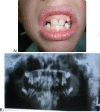Dental Number Anomalies and Their Prevalence According To Gender and Jaw in School Children 7 To 14 Years
- PMID: 29875863
- PMCID: PMC5985881
- DOI: 10.3889/oamjms.2018.174
Dental Number Anomalies and Their Prevalence According To Gender and Jaw in School Children 7 To 14 Years
Abstract
Objectives: This study aimed to find the prevalence of Hypodontia and Hyperdontia in different ethnicities in patients from 7 to 14 years old.
Material and methods: A group of 520 children were included aged 7 to 14 years, only the children who went to primary schools. Controls were performed by professional people to preserve the criteria of orthodontic abnormalities evaluation. The data were recorded in the individual card specially formulated for this research and all the patients suspected for hypodontia and hyperdontia the orthopantomography for confirmation was made. The data were analysed using descriptive statistical analysis using χ2 test for the significant difference for p ˂ 0.05 and Fisher test for p < 0.05.
Results: Hypodontia, not counting the patients with missing third molars was found in 18 patients researched or 3.46%. The most commonly missing teeth were the second lower premolars, the second upper premolars, second upper lateral incisors followed by the lower incisors. Hyperdontia not including the third molars was found in 4 cases of the participants or 0.76% from which the most frequent atypical tooth mesiodens and one case of bilateral hypodontia of a lateral upper incisor with typical shape and size. But there were no significant differences when tested between genders and jaws.
Conclusion: The prevalence we found is similar to the prevalence in the region. Our findings indicate that there is a difference between the genders in the prevalence of hypodontia, but without statistical significance, while for hyperdontia we can't see such a difference between the sexes.
Keywords: Hyperdontia; Hypodontia; children; ethnics.
Figures
References
-
- Jorgenson RJ. Clincinas view of hypdontia J. Am Dent Assoc. 1980;101:283–286. https://doi.org/10.14219/jada.archive.1980.0186. - PubMed
-
- Wei SHY. Pediatric dentistry total patient care lex and Febiger Philadelphia. 1988:362–365.
-
- Vastardis H. The genetics of human tooth agenesis:new discoveries for understanding dental anomalies. American Journal of Orthodontics Dentofacial Orthopedics. 2000;117(6):650–6. https://doi.org/10.1016/S0889-5406(00)70173-9. - PubMed
-
- Arte S. Phenotipic and Genotipic features of familial hypodontia Thesis University of Helsinki. 2001
LinkOut - more resources
Full Text Sources
Other Literature Sources




